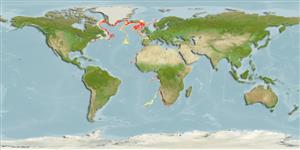Elasmobranquios (tiburones y rayas) (sharks and rays) >
Rajiformes (Skates and rays) >
Rajidae (Skates)
Etymology: Malacoraja: Greek, malakos = soft + Latin, raja, -ae = ray, fis (Raja sp.) (Ref. 45335).
More on author: Barnard.
Environment: milieu / climate zone / depth range / distribution range
Ecología
marino batidemersal; rango de profundidad 450 - 1570 m (Ref. 117245). Deep-water; 3°C - 5°C (Ref. 117245); 67°N - 38°S, 72°W - 25°E
Eastern Atlantic: Baffin Bay-Davis Strait Offshore to Iceland-Faeroe Ridge, off northwest Africa (Rio de Oro), off southern Namibia and South Africa.
Tamaño / Peso / Age
Maturity: Lm ? range ? - ? cm
Max length : 70.0 cm TL macho / no sexado; (Ref. 4426)
Short description
Claves de identificación | Morfología | Morfometría
Very broad, almost pentagonal disc, light above and abruptly dark below; snout bluntly pointed with a flexible tip, eyes small and close together, and a disc with broadly rounded rear margins and tips (Ref. 5578). Small juveniles with and adults without thorns and covered only with small denticles (Ref. 5578). Slate-grey or greyish-brown above except rear margins of pectoral and pelvic fins and claspers of adult males which are dark brown; dark brown below, sometimes with light blotches (Ref. 5578). Lack of large thorns on its disc posterior to the scapular region (Ref. 6902).
A very rare species inhabiting continental slopes and probably down to the abyssal plains (Ref. 3167). Benthic (Ref. 58426). Adults usually at depths greater than 1,500 m while juveniles are mainly taken from about 450 m downward (Ref. 4426). Minimum depth reported taken from Ref. 4426. Feeds on crustaceans (Ref. 58426). Oviparous (Ref. 50449). Eggs have horn-like projections on the shell (Ref. 205). This species is occasionally captured as by-catch (Ref. 117245).
Life cycle and mating behavior
Madurez | Reproducción | Puesta | Huevos | Fecundidad | Larva
Oviparous (Ref. 3167). Paired eggs are laid. Embryos feed solely on yolk (Ref. 50449).
McEachran, J.D. and K.A. Dunn, 1998. Phylogenetic analysis of skates, a morphologically conservative clade of elasmobranchs (Chondrichthyes: Rajidae). Copeia 1998(2):271-290. (Ref. 27314)
IUCN Red List Status (Ref. 130435: Version 2024-1)
Threat to humans
Harmless
Human uses
Pesquerías: sin interés
Herramientas
Special reports
Download XML
Fuentes de Internet
Estimates based on models
Preferred temperature (Ref.
123201): 3.3 - 8.5, mean 5.9 °C (based on 122 cells).
Phylogenetic diversity index (Ref.
82804): PD
50 = 0.5625 [Uniqueness, from 0.5 = low to 2.0 = high].
Bayesian length-weight: a=0.00302 (0.00141 - 0.00645), b=3.24 (3.07 - 3.41), in cm total length, based on LWR estimates for this (Sub)family-body shape (Ref.
93245).
Nivel trófico (Ref.
69278): 3.8 ±0.61 se; based on food items.
Resiliencia (Ref.
120179): Bajo, población duplicada en un tiempo mínimo de 4.5-14 años (Fec assumed to be <100).
Fishing Vulnerability (Ref.
59153): Moderate to high vulnerability (48 of 100).
Nutrients (Ref.
124155): Calcium = 9.46 [1.70, 47.25] mg/100g; Iron = 0.362 [0.086, 1.103] mg/100g; Protein = 16.6 [13.7, 19.2] %; Omega3 = 0.61 [0.18, 2.41] g/100g; Selenium = 14.7 [3.9, 48.4] μg/100g; VitaminA = 7.61 [1.88, 30.80] μg/100g; Zinc = 0.341 [0.168, 0.630] mg/100g (wet weight);
